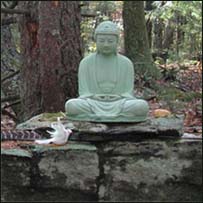|
|
 |
Please support Dharma Seed with a 2025 year-end gift.
Your donations allow us to offer these teachings online to all.

|

|

|
The greatest gift is the
gift of the teachings
|
|

|
| |
|
Retreat Dharma Talks
|
|
Entering the Dhamma Fields: A Five Day Residential Retreat with Ajahn Sucitto

|
| Location: The Won Dharma Center, 361 State Route 23, Claverack, NY |
|
2018-10-10 (6 days)
New York Insight Meditation Center
|
|
| |
|
2018-10-12
11 Day 3 Evening Puja: Learning to Prefer Dispassion
63:01
|
|
Ajahn Sucitto
|
|
|
In citta’s maturing process, it goes from seeking stability and comfort in things that can never satisfy, to finding a place of dispassion. It learns that disengagement is preferable to getting fired up, disappointed, humiliated. In this letting go it finally finds the stability and happiness it has been seeking.
|
|
2018-10-13
12 Day 4 Morning Puja: Think Short, Listen Long
22:31
|
|
Ajahn Sucitto
|
|
|
Instruction on disengaging attention from mental contact. Disengagement allows for longer listening time. The quality of listening has a different tone – softer, more open, the ability to be with but not in. That non-engaged space allows for signs of comfort, contentment and gladness to arise. It’s not in the object but in the relationship. Keep re-establishing relationship to the chosen object.
|
|
2018-10-13
13 Day 4 Morning Instructions: Heart Yoga
48:49
|
|
Ajahn Sucitto
|
|
|
Relationship is always necessary, always there, whether with other people or with ourselves. To absorb into comfortable relationship, and clear this area from greed, hatred and fear, there has to be a lot of negotiation, the back and forth movement of disengaging, then returning again. This is true yoga of the heart. To keep the heart flexible and responsive, brahmavihārā ‘asanas’ are suggested.
|
|
2018-10-13
14 Day 4 Guided Meditation: Goodwill
23:27
|
|
Ajahn Sucitto
|
|
|
Citta is moved by images that can be sparked by thought, visual, auditory or somatic/felt experience. This guided meditation accesses these portals to generate receptivity and resonances of goodwill within yourself, then spread them out.
|
|
2018-10-13
16 Day 4 Evening Puja: Q&A
67:49
|
|
Ajahn Sucitto
|
|
|
Different ways of presenting Dhamma in Theravada Buddhism (single-pointed, ‘dry insight’; Thai forest). Are there certain thought patterns that are related to nervous energy in the body? How do you do discharge? Metta practice as cultivating non-aversive, non-contractive state rather than a doing/sending out. Clarifying the term ‘fields’. Qi Gong questions (is it normal to get so hot while practicing Qi Gong? Is it good to use wu qi for standing meditation?); Responding to sexual awareness in the presence of others. Skillfully handling trauma that are still alive. Distinction between perception and consciousness. How feelings and emotions are experienced in Samadhi. Reclining meditation
|
|
2018-10-14
17 Day 5 Morning Puja: Lingering
54:42
|
|
Ajahn Sucitto
|
|
|
Beginning our day, we make the intention to enter the Dhamma field before entering the hallucinatory field constructed of time and space. Refrain from what’s not needed, linger in what’s needed. What you linger with increases. If you linger in the world of suppositions - ‘got to do, should do’- that increases. Find out what’s truly needed and linger there.
|
|
2018-10-14
18 Day 5 Guided Meditation Intention – a Softer Effort
46:47
|
|
Ajahn Sucitto
|
|
|
Using intention in practice means there is a wish, a prayer, an aspiration – subtle movements of energy rather than the push of effort. If we use intention too forcefully we block receptivity. It’s up to us to determine what’s skillful at this time. Perhaps it’s the intention to relax, set aside, widen, soften. Wisdom is our guide, and effort is just to use wisdom to arrive at deeper wisdom. [8:15 Begin Standing Meditation Instructions] Translating Anatomical Descriptions into Felt Sense: We all use anatomical descriptions of the body as a sketch, but the encouragement in this meditation is to translate them into energetic or felt experiences. Beginning with physical experience, guidance is provided to sense into subtler energies and felt tones and meanings.
|
|
2018-10-14
19 Day 5 Morning Instructions: Maps that Dispel Differentiation
53:22
|
|
Ajahn Sucitto
|
|
|
The Buddha expounded Dhamma using various maps. The map of the khandhā and dependent origination provide means for understanding and responding to experience without the sense of a fixed self. Meeting and relating to phenomena in the body, free from aversion and resistance, you don’t have to like it, just accept it. This is the way out of suffering.
|
|
2018-10-14
20 Day 5 Evening Puja: Wilderness Training
25:00
|
|
Ajahn Sucitto
|
|
|
We struggle for certainty and clarity, but the true orientation of Dhamma is disorientation from old maps, thereby allowing forms to arise and change with disengaged attention. Then we’re much more alert and agile. This is wilderness training.
|
|
|
|
|